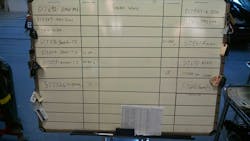Many of the most efficient shops use a visual production board to demonstrate where vehicles are in the repair process. The system can be as simple as a whiteboard, or more complex, as part of an overall visual scheduling system.
The goal is to maximize a shop’s efficiency by taking a more strategic approach to job priority and ensuring that every member of the staff is aware of a vehicle’s status in the repair process. Jay Pope, director of operations at DCR Systems shops, which creates turnkey collision shops for dealerships, explains the process of setting up a visual production board.
There are a number of different visual cues we use to identify where vehicles are in the repair process. They all work together to streamline the efficiency of the repair process and help departments communicate more easily. Altogether, those queues are our electronic management system, identified and marked spaces within the shop floor, parts carts staging, the organization of our parking lot, and the queue board.
The queue board is a big white board that demonstrates the cars that are queued to come in next. The reason we started doing this in addition to our other visuals is that in the past, the technicians would just look at their identified spaces, see an empty spot, go to the management system and pull in the car that they want to pull in. I quickly realized that that couldn’t happen and that we needed to have an order for the cars coming in and going through the repair process.
The white board looks like a huge chart. On the top, each of our departments is listed as a separate column. Then, there are 10 rows numbered 1–10. That is where we list the jobs in order of importance. A member of the leadership team looks at all of the vehicles in process and strategically chooses the order. We will look at the delivery date, if it’s a customer-pay vehicle or a DRP job, if two ROs can be painted at the same time, or if parts can be taken off the car. All of those factors can really increase efficiency. For example, we can advance smaller, faster repairs by jumping a larger repair that will take longer. That way, those smaller jobs aren’t taking the same amount of time as a larger repair.
After deciding on the order, the member of the leadership team will then create a “folder” for each job that is hung on the board. That folder contains the arrival date, target date, basic vehicle information, RO number and a set of keys. That allows each member of the team to easily have access to all information needed.
Once the board is created, the technicians can begin with the car listed as the first priority. The start of our production line begins with repairs, so that is the first column. That means that a car is washed and wiped down, sitting in the designated queue stall, and ready to go for repairs. After the first job is started, the next technician will take the second job listed. Again, doing this eliminates any guess work for the technician.
As the car moves through the repair process, the technician will move the job into the next column to indicate where the vehicle is in the repair process.
It is also easy to customize this board with additional information. For example, you could add body and paint efficiency numbers for the week or the past week, as well as individual technician efficiency numbers. Even though this is all information that is gathered in our management system, I think it is valuable to have it visually available at a glance to everyone in the shop.



